Analysis of Rio Tinto's Organisational Culture and Leadership
VerifiedAdded on 2020/12/24
|11
|3359
|374
Report
AI Summary
This report provides a comprehensive analysis of Rio Tinto's organizational culture, focusing on leadership, communication, and employee commitment. It explores the components of a strong organizational culture and the importance of leadership in a multicultural environment, highlighting the need for leaders to understand cultural gaps, language barriers, and adapt to local cultures. The report applies Hofstede's cultural dimension theory to Rio Tinto, examining power distance, individualism, masculinity, uncertainty avoidance, and long-term orientation. It also discusses the influence of organizational culture on decision-making, ethical practices, and social responsibility, including the application of Handy's Model to the company. The report emphasizes the significance of team coordination, corporate vision, and the impact of ethical considerations on employee behavior, ultimately contributing to Rio Tinto's overall success. The report also emphasizes the importance of leadership in a multicultural setting, highlighting the need for leaders to bridge cultural gaps, overcome language barriers, and foster effective team coordination to achieve organizational goals.
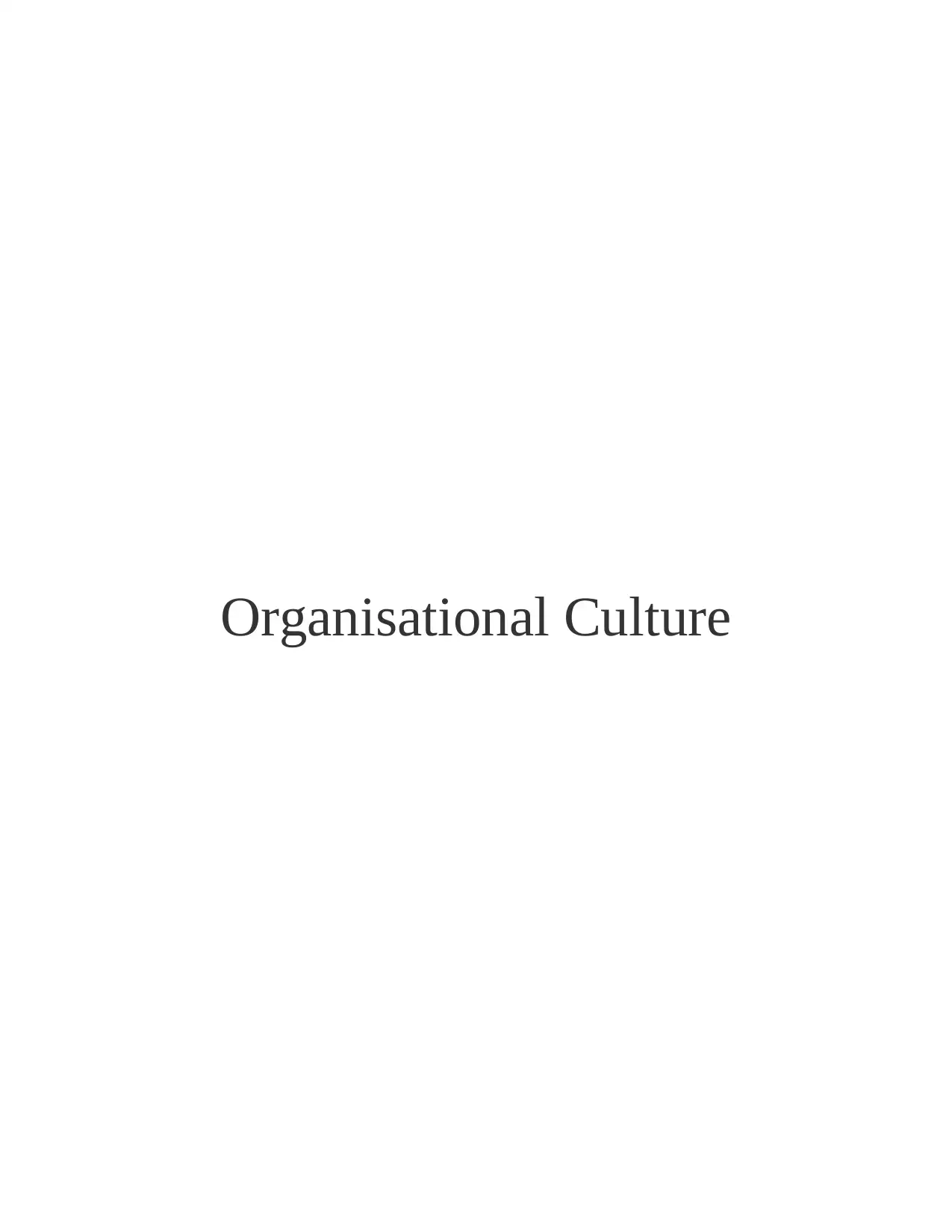
Organisational Culture
Paraphrase This Document
Need a fresh take? Get an instant paraphrase of this document with our AI Paraphraser
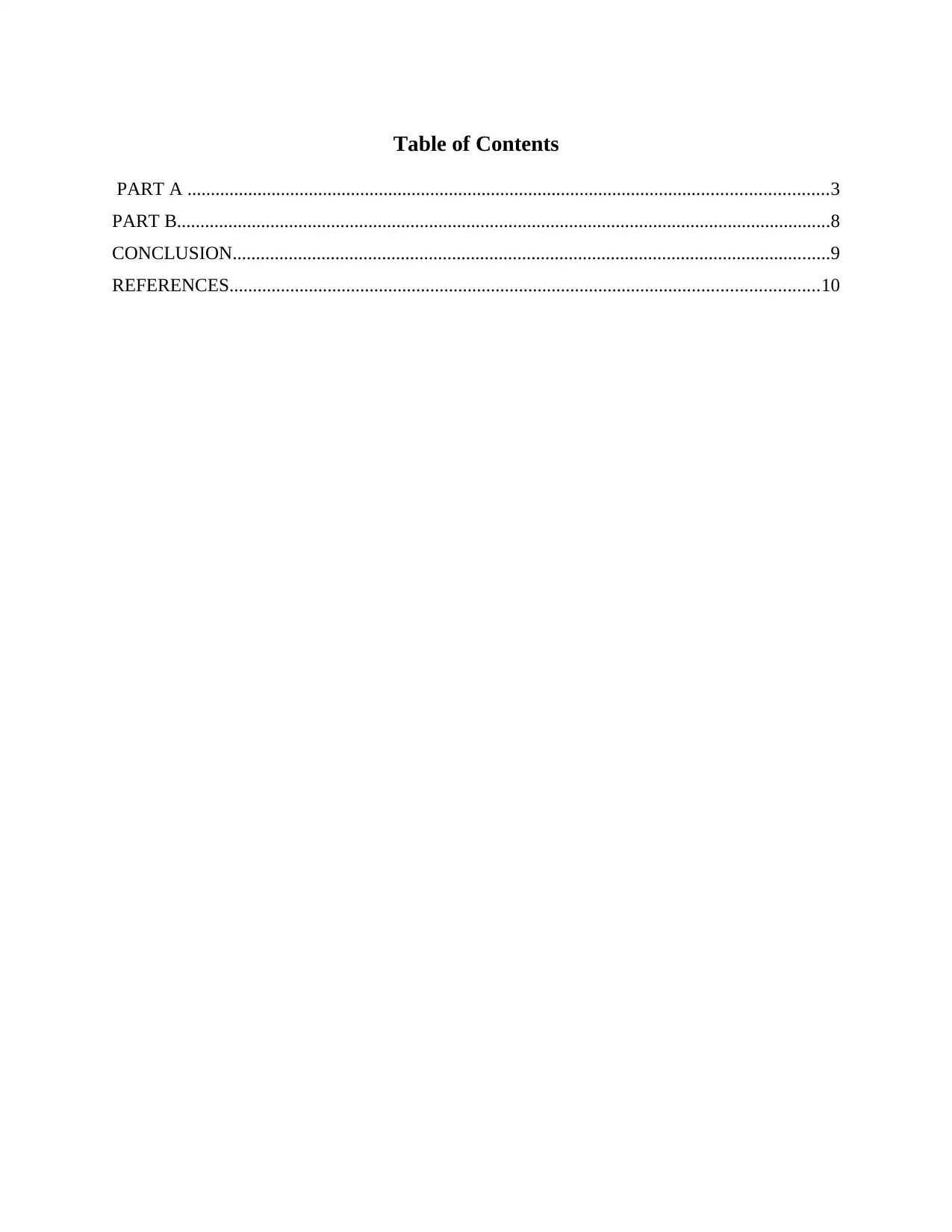
Table of Contents
PART A .........................................................................................................................................3
PART B............................................................................................................................................8
CONCLUSION................................................................................................................................9
REFERENCES..............................................................................................................................10
PART A .........................................................................................................................................3
PART B............................................................................................................................................8
CONCLUSION................................................................................................................................9
REFERENCES..............................................................................................................................10
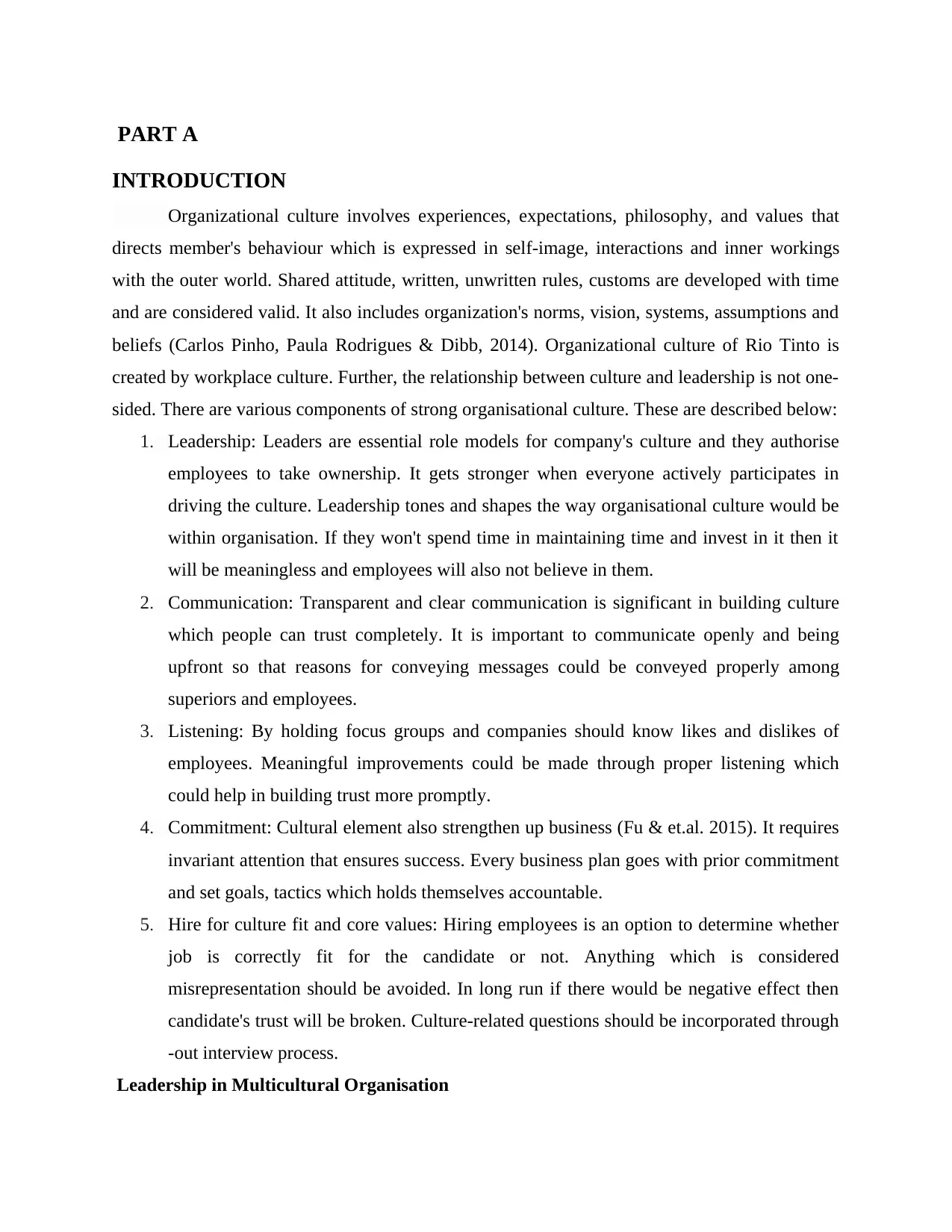
PART A
INTRODUCTION
Organizational culture involves experiences, expectations, philosophy, and values that
directs member's behaviour which is expressed in self-image, interactions and inner workings
with the outer world. Shared attitude, written, unwritten rules, customs are developed with time
and are considered valid. It also includes organization's norms, vision, systems, assumptions and
beliefs (Carlos Pinho, Paula Rodrigues & Dibb, 2014). Organizational culture of Rio Tinto is
created by workplace culture. Further, the relationship between culture and leadership is not one-
sided. There are various components of strong organisational culture. These are described below:
1. Leadership: Leaders are essential role models for company's culture and they authorise
employees to take ownership. It gets stronger when everyone actively participates in
driving the culture. Leadership tones and shapes the way organisational culture would be
within organisation. If they won't spend time in maintaining time and invest in it then it
will be meaningless and employees will also not believe in them.
2. Communication: Transparent and clear communication is significant in building culture
which people can trust completely. It is important to communicate openly and being
upfront so that reasons for conveying messages could be conveyed properly among
superiors and employees.
3. Listening: By holding focus groups and companies should know likes and dislikes of
employees. Meaningful improvements could be made through proper listening which
could help in building trust more promptly.
4. Commitment: Cultural element also strengthen up business (Fu & et.al. 2015). It requires
invariant attention that ensures success. Every business plan goes with prior commitment
and set goals, tactics which holds themselves accountable.
5. Hire for culture fit and core values: Hiring employees is an option to determine whether
job is correctly fit for the candidate or not. Anything which is considered
misrepresentation should be avoided. In long run if there would be negative effect then
candidate's trust will be broken. Culture-related questions should be incorporated through
-out interview process.
Leadership in Multicultural Organisation
INTRODUCTION
Organizational culture involves experiences, expectations, philosophy, and values that
directs member's behaviour which is expressed in self-image, interactions and inner workings
with the outer world. Shared attitude, written, unwritten rules, customs are developed with time
and are considered valid. It also includes organization's norms, vision, systems, assumptions and
beliefs (Carlos Pinho, Paula Rodrigues & Dibb, 2014). Organizational culture of Rio Tinto is
created by workplace culture. Further, the relationship between culture and leadership is not one-
sided. There are various components of strong organisational culture. These are described below:
1. Leadership: Leaders are essential role models for company's culture and they authorise
employees to take ownership. It gets stronger when everyone actively participates in
driving the culture. Leadership tones and shapes the way organisational culture would be
within organisation. If they won't spend time in maintaining time and invest in it then it
will be meaningless and employees will also not believe in them.
2. Communication: Transparent and clear communication is significant in building culture
which people can trust completely. It is important to communicate openly and being
upfront so that reasons for conveying messages could be conveyed properly among
superiors and employees.
3. Listening: By holding focus groups and companies should know likes and dislikes of
employees. Meaningful improvements could be made through proper listening which
could help in building trust more promptly.
4. Commitment: Cultural element also strengthen up business (Fu & et.al. 2015). It requires
invariant attention that ensures success. Every business plan goes with prior commitment
and set goals, tactics which holds themselves accountable.
5. Hire for culture fit and core values: Hiring employees is an option to determine whether
job is correctly fit for the candidate or not. Anything which is considered
misrepresentation should be avoided. In long run if there would be negative effect then
candidate's trust will be broken. Culture-related questions should be incorporated through
-out interview process.
Leadership in Multicultural Organisation
⊘ This is a preview!⊘
Do you want full access?
Subscribe today to unlock all pages.

Trusted by 1+ million students worldwide
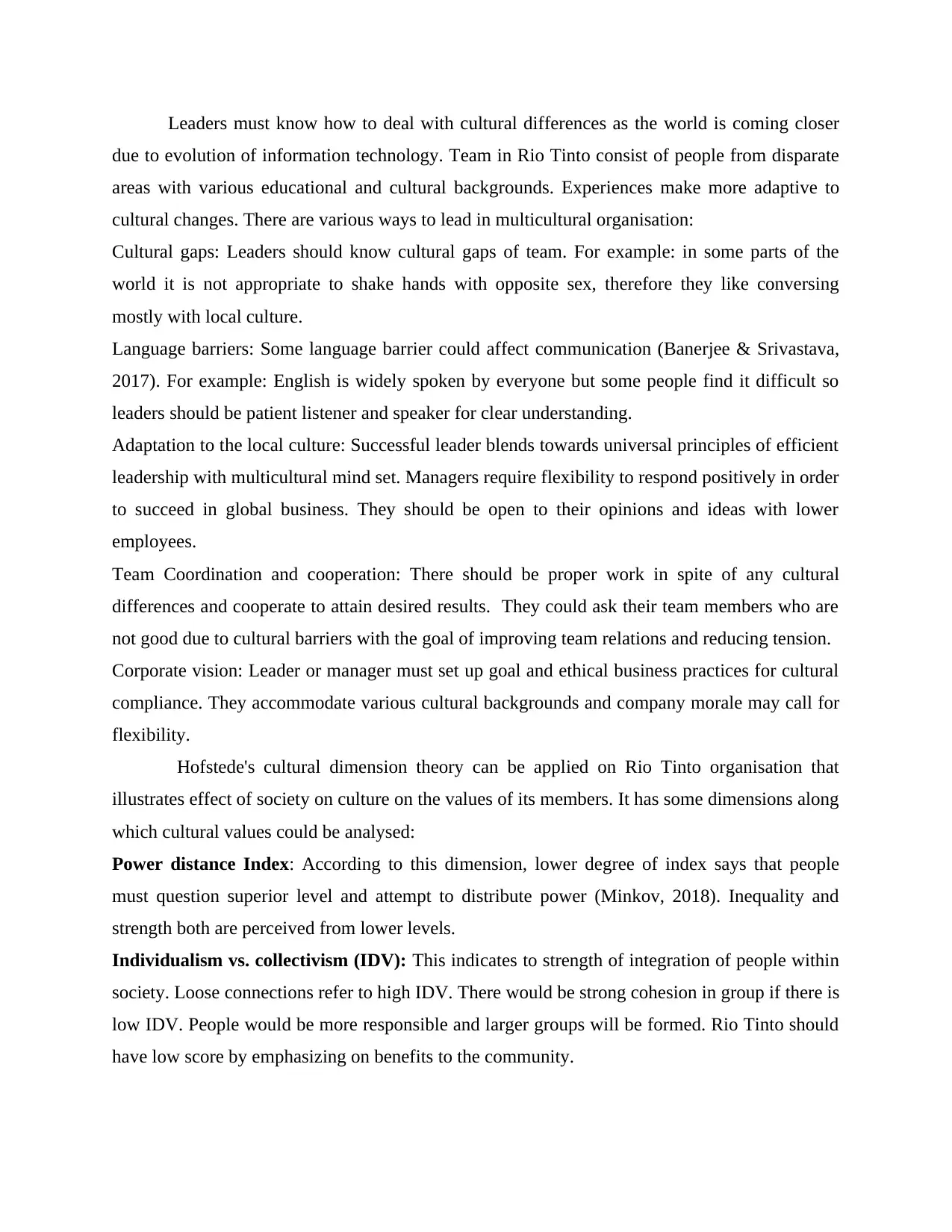
Leaders must know how to deal with cultural differences as the world is coming closer
due to evolution of information technology. Team in Rio Tinto consist of people from disparate
areas with various educational and cultural backgrounds. Experiences make more adaptive to
cultural changes. There are various ways to lead in multicultural organisation:
Cultural gaps: Leaders should know cultural gaps of team. For example: in some parts of the
world it is not appropriate to shake hands with opposite sex, therefore they like conversing
mostly with local culture.
Language barriers: Some language barrier could affect communication (Banerjee & Srivastava,
2017). For example: English is widely spoken by everyone but some people find it difficult so
leaders should be patient listener and speaker for clear understanding.
Adaptation to the local culture: Successful leader blends towards universal principles of efficient
leadership with multicultural mind set. Managers require flexibility to respond positively in order
to succeed in global business. They should be open to their opinions and ideas with lower
employees.
Team Coordination and cooperation: There should be proper work in spite of any cultural
differences and cooperate to attain desired results. They could ask their team members who are
not good due to cultural barriers with the goal of improving team relations and reducing tension.
Corporate vision: Leader or manager must set up goal and ethical business practices for cultural
compliance. They accommodate various cultural backgrounds and company morale may call for
flexibility.
Hofstede's cultural dimension theory can be applied on Rio Tinto organisation that
illustrates effect of society on culture on the values of its members. It has some dimensions along
which cultural values could be analysed:
Power distance Index: According to this dimension, lower degree of index says that people
must question superior level and attempt to distribute power (Minkov, 2018). Inequality and
strength both are perceived from lower levels.
Individualism vs. collectivism (IDV): This indicates to strength of integration of people within
society. Loose connections refer to high IDV. There would be strong cohesion in group if there is
low IDV. People would be more responsible and larger groups will be formed. Rio Tinto should
have low score by emphasizing on benefits to the community.
due to evolution of information technology. Team in Rio Tinto consist of people from disparate
areas with various educational and cultural backgrounds. Experiences make more adaptive to
cultural changes. There are various ways to lead in multicultural organisation:
Cultural gaps: Leaders should know cultural gaps of team. For example: in some parts of the
world it is not appropriate to shake hands with opposite sex, therefore they like conversing
mostly with local culture.
Language barriers: Some language barrier could affect communication (Banerjee & Srivastava,
2017). For example: English is widely spoken by everyone but some people find it difficult so
leaders should be patient listener and speaker for clear understanding.
Adaptation to the local culture: Successful leader blends towards universal principles of efficient
leadership with multicultural mind set. Managers require flexibility to respond positively in order
to succeed in global business. They should be open to their opinions and ideas with lower
employees.
Team Coordination and cooperation: There should be proper work in spite of any cultural
differences and cooperate to attain desired results. They could ask their team members who are
not good due to cultural barriers with the goal of improving team relations and reducing tension.
Corporate vision: Leader or manager must set up goal and ethical business practices for cultural
compliance. They accommodate various cultural backgrounds and company morale may call for
flexibility.
Hofstede's cultural dimension theory can be applied on Rio Tinto organisation that
illustrates effect of society on culture on the values of its members. It has some dimensions along
which cultural values could be analysed:
Power distance Index: According to this dimension, lower degree of index says that people
must question superior level and attempt to distribute power (Minkov, 2018). Inequality and
strength both are perceived from lower levels.
Individualism vs. collectivism (IDV): This indicates to strength of integration of people within
society. Loose connections refer to high IDV. There would be strong cohesion in group if there is
low IDV. People would be more responsible and larger groups will be formed. Rio Tinto should
have low score by emphasizing on benefits to the community.
Paraphrase This Document
Need a fresh take? Get an instant paraphrase of this document with our AI Paraphraser
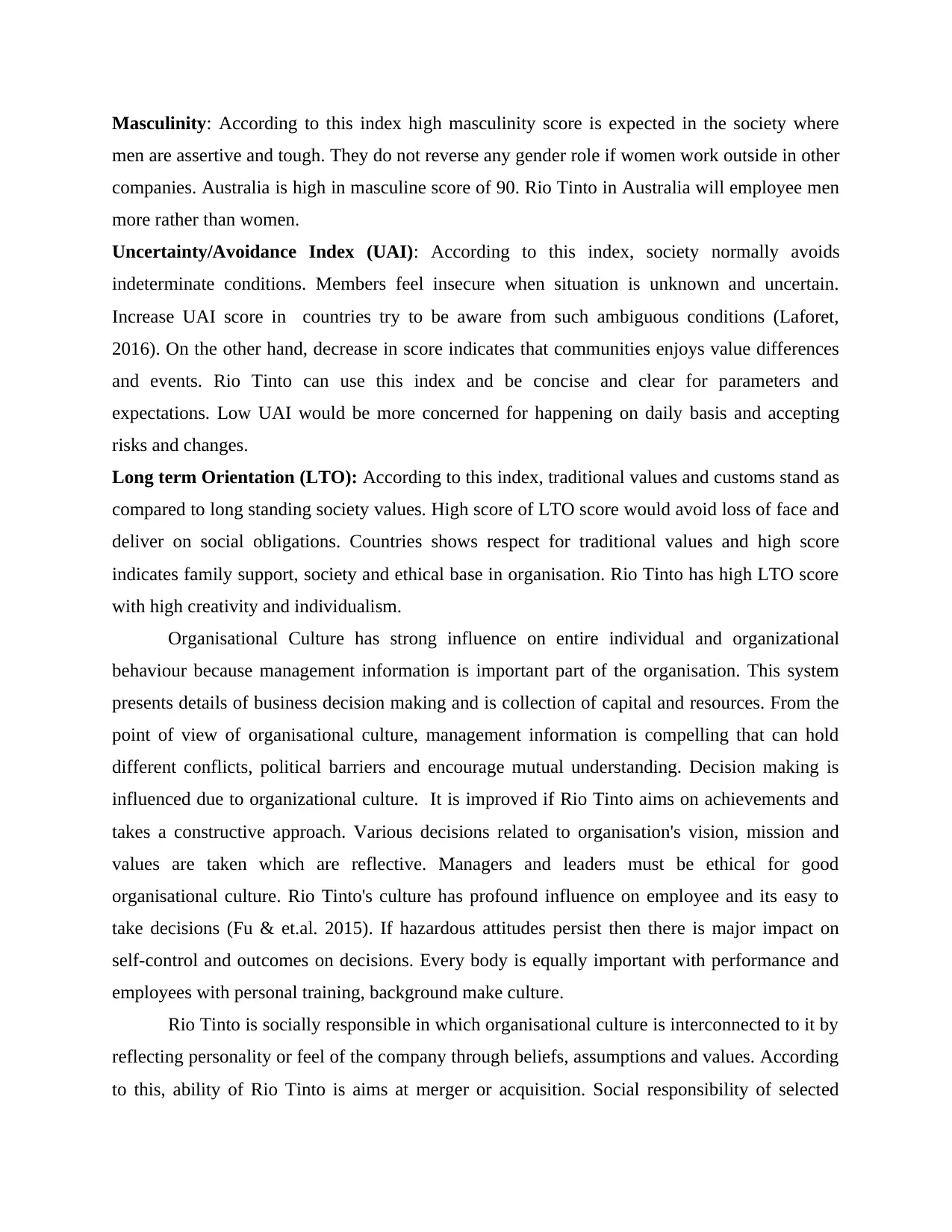
Masculinity: According to this index high masculinity score is expected in the society where
men are assertive and tough. They do not reverse any gender role if women work outside in other
companies. Australia is high in masculine score of 90. Rio Tinto in Australia will employee men
more rather than women.
Uncertainty/Avoidance Index (UAI): According to this index, society normally avoids
indeterminate conditions. Members feel insecure when situation is unknown and uncertain.
Increase UAI score in countries try to be aware from such ambiguous conditions (Laforet,
2016). On the other hand, decrease in score indicates that communities enjoys value differences
and events. Rio Tinto can use this index and be concise and clear for parameters and
expectations. Low UAI would be more concerned for happening on daily basis and accepting
risks and changes.
Long term Orientation (LTO): According to this index, traditional values and customs stand as
compared to long standing society values. High score of LTO score would avoid loss of face and
deliver on social obligations. Countries shows respect for traditional values and high score
indicates family support, society and ethical base in organisation. Rio Tinto has high LTO score
with high creativity and individualism.
Organisational Culture has strong influence on entire individual and organizational
behaviour because management information is important part of the organisation. This system
presents details of business decision making and is collection of capital and resources. From the
point of view of organisational culture, management information is compelling that can hold
different conflicts, political barriers and encourage mutual understanding. Decision making is
influenced due to organizational culture. It is improved if Rio Tinto aims on achievements and
takes a constructive approach. Various decisions related to organisation's vision, mission and
values are taken which are reflective. Managers and leaders must be ethical for good
organisational culture. Rio Tinto's culture has profound influence on employee and its easy to
take decisions (Fu & et.al. 2015). If hazardous attitudes persist then there is major impact on
self-control and outcomes on decisions. Every body is equally important with performance and
employees with personal training, background make culture.
Rio Tinto is socially responsible in which organisational culture is interconnected to it by
reflecting personality or feel of the company through beliefs, assumptions and values. According
to this, ability of Rio Tinto is aims at merger or acquisition. Social responsibility of selected
men are assertive and tough. They do not reverse any gender role if women work outside in other
companies. Australia is high in masculine score of 90. Rio Tinto in Australia will employee men
more rather than women.
Uncertainty/Avoidance Index (UAI): According to this index, society normally avoids
indeterminate conditions. Members feel insecure when situation is unknown and uncertain.
Increase UAI score in countries try to be aware from such ambiguous conditions (Laforet,
2016). On the other hand, decrease in score indicates that communities enjoys value differences
and events. Rio Tinto can use this index and be concise and clear for parameters and
expectations. Low UAI would be more concerned for happening on daily basis and accepting
risks and changes.
Long term Orientation (LTO): According to this index, traditional values and customs stand as
compared to long standing society values. High score of LTO score would avoid loss of face and
deliver on social obligations. Countries shows respect for traditional values and high score
indicates family support, society and ethical base in organisation. Rio Tinto has high LTO score
with high creativity and individualism.
Organisational Culture has strong influence on entire individual and organizational
behaviour because management information is important part of the organisation. This system
presents details of business decision making and is collection of capital and resources. From the
point of view of organisational culture, management information is compelling that can hold
different conflicts, political barriers and encourage mutual understanding. Decision making is
influenced due to organizational culture. It is improved if Rio Tinto aims on achievements and
takes a constructive approach. Various decisions related to organisation's vision, mission and
values are taken which are reflective. Managers and leaders must be ethical for good
organisational culture. Rio Tinto's culture has profound influence on employee and its easy to
take decisions (Fu & et.al. 2015). If hazardous attitudes persist then there is major impact on
self-control and outcomes on decisions. Every body is equally important with performance and
employees with personal training, background make culture.
Rio Tinto is socially responsible in which organisational culture is interconnected to it by
reflecting personality or feel of the company through beliefs, assumptions and values. According
to this, ability of Rio Tinto is aims at merger or acquisition. Social responsibility of selected
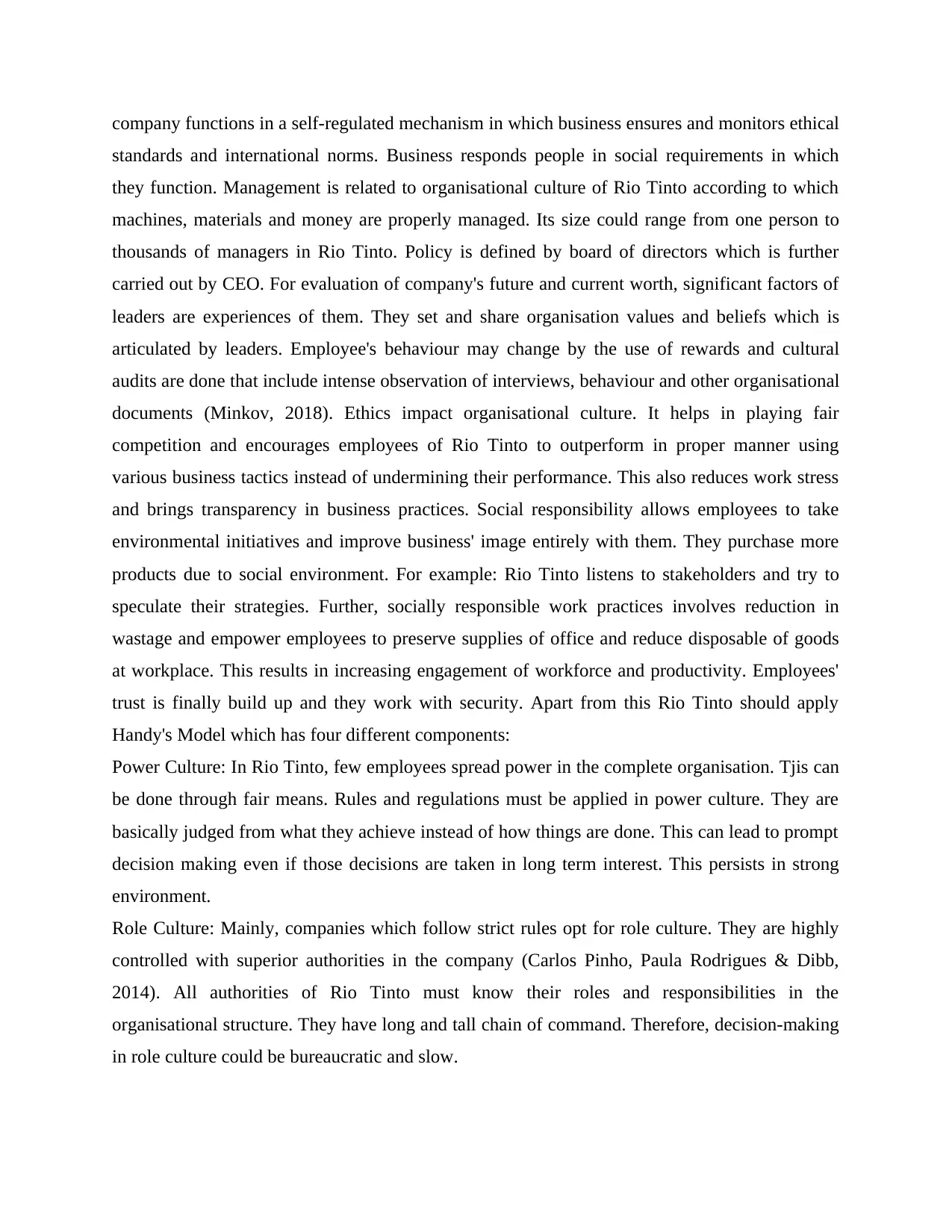
company functions in a self-regulated mechanism in which business ensures and monitors ethical
standards and international norms. Business responds people in social requirements in which
they function. Management is related to organisational culture of Rio Tinto according to which
machines, materials and money are properly managed. Its size could range from one person to
thousands of managers in Rio Tinto. Policy is defined by board of directors which is further
carried out by CEO. For evaluation of company's future and current worth, significant factors of
leaders are experiences of them. They set and share organisation values and beliefs which is
articulated by leaders. Employee's behaviour may change by the use of rewards and cultural
audits are done that include intense observation of interviews, behaviour and other organisational
documents (Minkov, 2018). Ethics impact organisational culture. It helps in playing fair
competition and encourages employees of Rio Tinto to outperform in proper manner using
various business tactics instead of undermining their performance. This also reduces work stress
and brings transparency in business practices. Social responsibility allows employees to take
environmental initiatives and improve business' image entirely with them. They purchase more
products due to social environment. For example: Rio Tinto listens to stakeholders and try to
speculate their strategies. Further, socially responsible work practices involves reduction in
wastage and empower employees to preserve supplies of office and reduce disposable of goods
at workplace. This results in increasing engagement of workforce and productivity. Employees'
trust is finally build up and they work with security. Apart from this Rio Tinto should apply
Handy's Model which has four different components:
Power Culture: In Rio Tinto, few employees spread power in the complete organisation. Tjis can
be done through fair means. Rules and regulations must be applied in power culture. They are
basically judged from what they achieve instead of how things are done. This can lead to prompt
decision making even if those decisions are taken in long term interest. This persists in strong
environment.
Role Culture: Mainly, companies which follow strict rules opt for role culture. They are highly
controlled with superior authorities in the company (Carlos Pinho, Paula Rodrigues & Dibb,
2014). All authorities of Rio Tinto must know their roles and responsibilities in the
organisational structure. They have long and tall chain of command. Therefore, decision-making
in role culture could be bureaucratic and slow.
standards and international norms. Business responds people in social requirements in which
they function. Management is related to organisational culture of Rio Tinto according to which
machines, materials and money are properly managed. Its size could range from one person to
thousands of managers in Rio Tinto. Policy is defined by board of directors which is further
carried out by CEO. For evaluation of company's future and current worth, significant factors of
leaders are experiences of them. They set and share organisation values and beliefs which is
articulated by leaders. Employee's behaviour may change by the use of rewards and cultural
audits are done that include intense observation of interviews, behaviour and other organisational
documents (Minkov, 2018). Ethics impact organisational culture. It helps in playing fair
competition and encourages employees of Rio Tinto to outperform in proper manner using
various business tactics instead of undermining their performance. This also reduces work stress
and brings transparency in business practices. Social responsibility allows employees to take
environmental initiatives and improve business' image entirely with them. They purchase more
products due to social environment. For example: Rio Tinto listens to stakeholders and try to
speculate their strategies. Further, socially responsible work practices involves reduction in
wastage and empower employees to preserve supplies of office and reduce disposable of goods
at workplace. This results in increasing engagement of workforce and productivity. Employees'
trust is finally build up and they work with security. Apart from this Rio Tinto should apply
Handy's Model which has four different components:
Power Culture: In Rio Tinto, few employees spread power in the complete organisation. Tjis can
be done through fair means. Rules and regulations must be applied in power culture. They are
basically judged from what they achieve instead of how things are done. This can lead to prompt
decision making even if those decisions are taken in long term interest. This persists in strong
environment.
Role Culture: Mainly, companies which follow strict rules opt for role culture. They are highly
controlled with superior authorities in the company (Carlos Pinho, Paula Rodrigues & Dibb,
2014). All authorities of Rio Tinto must know their roles and responsibilities in the
organisational structure. They have long and tall chain of command. Therefore, decision-making
in role culture could be bureaucratic and slow.
⊘ This is a preview!⊘
Do you want full access?
Subscribe today to unlock all pages.

Trusted by 1+ million students worldwide
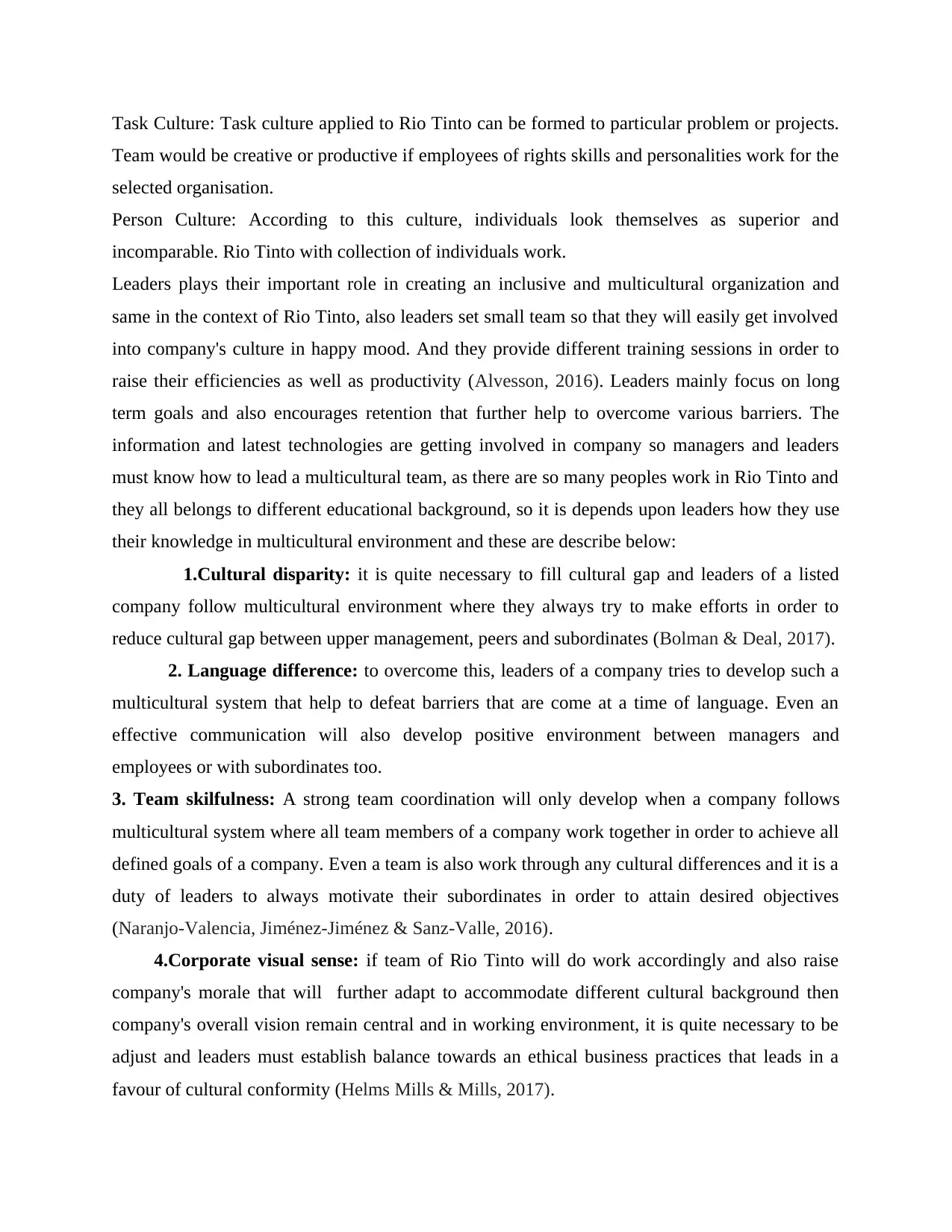
Task Culture: Task culture applied to Rio Tinto can be formed to particular problem or projects.
Team would be creative or productive if employees of rights skills and personalities work for the
selected organisation.
Person Culture: According to this culture, individuals look themselves as superior and
incomparable. Rio Tinto with collection of individuals work.
Leaders plays their important role in creating an inclusive and multicultural organization and
same in the context of Rio Tinto, also leaders set small team so that they will easily get involved
into company's culture in happy mood. And they provide different training sessions in order to
raise their efficiencies as well as productivity (Alvesson, 2016). Leaders mainly focus on long
term goals and also encourages retention that further help to overcome various barriers. The
information and latest technologies are getting involved in company so managers and leaders
must know how to lead a multicultural team, as there are so many peoples work in Rio Tinto and
they all belongs to different educational background, so it is depends upon leaders how they use
their knowledge in multicultural environment and these are describe below:
1.Cultural disparity: it is quite necessary to fill cultural gap and leaders of a listed
company follow multicultural environment where they always try to make efforts in order to
reduce cultural gap between upper management, peers and subordinates (Bolman & Deal, 2017).
2. Language difference: to overcome this, leaders of a company tries to develop such a
multicultural system that help to defeat barriers that are come at a time of language. Even an
effective communication will also develop positive environment between managers and
employees or with subordinates too.
3. Team skilfulness: A strong team coordination will only develop when a company follows
multicultural system where all team members of a company work together in order to achieve all
defined goals of a company. Even a team is also work through any cultural differences and it is a
duty of leaders to always motivate their subordinates in order to attain desired objectives
(Naranjo-Valencia, Jiménez-Jiménez & Sanz-Valle, 2016).
4.Corporate visual sense: if team of Rio Tinto will do work accordingly and also raise
company's morale that will further adapt to accommodate different cultural background then
company's overall vision remain central and in working environment, it is quite necessary to be
adjust and leaders must establish balance towards an ethical business practices that leads in a
favour of cultural conformity (Helms Mills & Mills, 2017).
Team would be creative or productive if employees of rights skills and personalities work for the
selected organisation.
Person Culture: According to this culture, individuals look themselves as superior and
incomparable. Rio Tinto with collection of individuals work.
Leaders plays their important role in creating an inclusive and multicultural organization and
same in the context of Rio Tinto, also leaders set small team so that they will easily get involved
into company's culture in happy mood. And they provide different training sessions in order to
raise their efficiencies as well as productivity (Alvesson, 2016). Leaders mainly focus on long
term goals and also encourages retention that further help to overcome various barriers. The
information and latest technologies are getting involved in company so managers and leaders
must know how to lead a multicultural team, as there are so many peoples work in Rio Tinto and
they all belongs to different educational background, so it is depends upon leaders how they use
their knowledge in multicultural environment and these are describe below:
1.Cultural disparity: it is quite necessary to fill cultural gap and leaders of a listed
company follow multicultural environment where they always try to make efforts in order to
reduce cultural gap between upper management, peers and subordinates (Bolman & Deal, 2017).
2. Language difference: to overcome this, leaders of a company tries to develop such a
multicultural system that help to defeat barriers that are come at a time of language. Even an
effective communication will also develop positive environment between managers and
employees or with subordinates too.
3. Team skilfulness: A strong team coordination will only develop when a company follows
multicultural system where all team members of a company work together in order to achieve all
defined goals of a company. Even a team is also work through any cultural differences and it is a
duty of leaders to always motivate their subordinates in order to attain desired objectives
(Naranjo-Valencia, Jiménez-Jiménez & Sanz-Valle, 2016).
4.Corporate visual sense: if team of Rio Tinto will do work accordingly and also raise
company's morale that will further adapt to accommodate different cultural background then
company's overall vision remain central and in working environment, it is quite necessary to be
adjust and leaders must establish balance towards an ethical business practices that leads in a
favour of cultural conformity (Helms Mills & Mills, 2017).
Paraphrase This Document
Need a fresh take? Get an instant paraphrase of this document with our AI Paraphraser
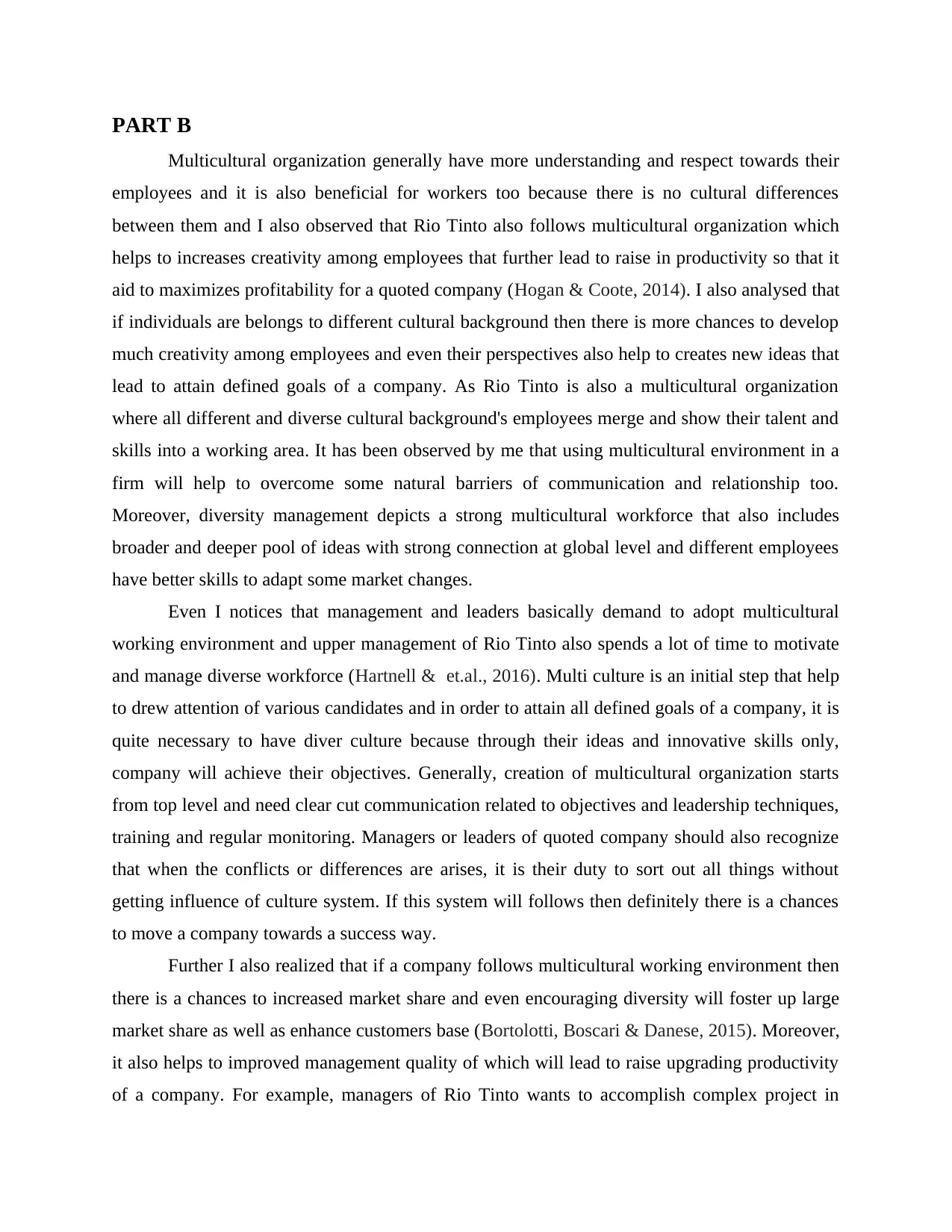
PART B
Multicultural organization generally have more understanding and respect towards their
employees and it is also beneficial for workers too because there is no cultural differences
between them and I also observed that Rio Tinto also follows multicultural organization which
helps to increases creativity among employees that further lead to raise in productivity so that it
aid to maximizes profitability for a quoted company (Hogan & Coote, 2014). I also analysed that
if individuals are belongs to different cultural background then there is more chances to develop
much creativity among employees and even their perspectives also help to creates new ideas that
lead to attain defined goals of a company. As Rio Tinto is also a multicultural organization
where all different and diverse cultural background's employees merge and show their talent and
skills into a working area. It has been observed by me that using multicultural environment in a
firm will help to overcome some natural barriers of communication and relationship too.
Moreover, diversity management depicts a strong multicultural workforce that also includes
broader and deeper pool of ideas with strong connection at global level and different employees
have better skills to adapt some market changes.
Even I notices that management and leaders basically demand to adopt multicultural
working environment and upper management of Rio Tinto also spends a lot of time to motivate
and manage diverse workforce (Hartnell & et.al., 2016). Multi culture is an initial step that help
to drew attention of various candidates and in order to attain all defined goals of a company, it is
quite necessary to have diver culture because through their ideas and innovative skills only,
company will achieve their objectives. Generally, creation of multicultural organization starts
from top level and need clear cut communication related to objectives and leadership techniques,
training and regular monitoring. Managers or leaders of quoted company should also recognize
that when the conflicts or differences are arises, it is their duty to sort out all things without
getting influence of culture system. If this system will follows then definitely there is a chances
to move a company towards a success way.
Further I also realized that if a company follows multicultural working environment then
there is a chances to increased market share and even encouraging diversity will foster up large
market share as well as enhance customers base (Bortolotti, Boscari & Danese, 2015). Moreover,
it also helps to improved management quality of which will lead to raise upgrading productivity
of a company. For example, managers of Rio Tinto wants to accomplish complex project in
Multicultural organization generally have more understanding and respect towards their
employees and it is also beneficial for workers too because there is no cultural differences
between them and I also observed that Rio Tinto also follows multicultural organization which
helps to increases creativity among employees that further lead to raise in productivity so that it
aid to maximizes profitability for a quoted company (Hogan & Coote, 2014). I also analysed that
if individuals are belongs to different cultural background then there is more chances to develop
much creativity among employees and even their perspectives also help to creates new ideas that
lead to attain defined goals of a company. As Rio Tinto is also a multicultural organization
where all different and diverse cultural background's employees merge and show their talent and
skills into a working area. It has been observed by me that using multicultural environment in a
firm will help to overcome some natural barriers of communication and relationship too.
Moreover, diversity management depicts a strong multicultural workforce that also includes
broader and deeper pool of ideas with strong connection at global level and different employees
have better skills to adapt some market changes.
Even I notices that management and leaders basically demand to adopt multicultural
working environment and upper management of Rio Tinto also spends a lot of time to motivate
and manage diverse workforce (Hartnell & et.al., 2016). Multi culture is an initial step that help
to drew attention of various candidates and in order to attain all defined goals of a company, it is
quite necessary to have diver culture because through their ideas and innovative skills only,
company will achieve their objectives. Generally, creation of multicultural organization starts
from top level and need clear cut communication related to objectives and leadership techniques,
training and regular monitoring. Managers or leaders of quoted company should also recognize
that when the conflicts or differences are arises, it is their duty to sort out all things without
getting influence of culture system. If this system will follows then definitely there is a chances
to move a company towards a success way.
Further I also realized that if a company follows multicultural working environment then
there is a chances to increased market share and even encouraging diversity will foster up large
market share as well as enhance customers base (Bortolotti, Boscari & Danese, 2015). Moreover,
it also helps to improved management quality of which will lead to raise upgrading productivity
of a company. For example, managers of Rio Tinto wants to accomplish complex project in
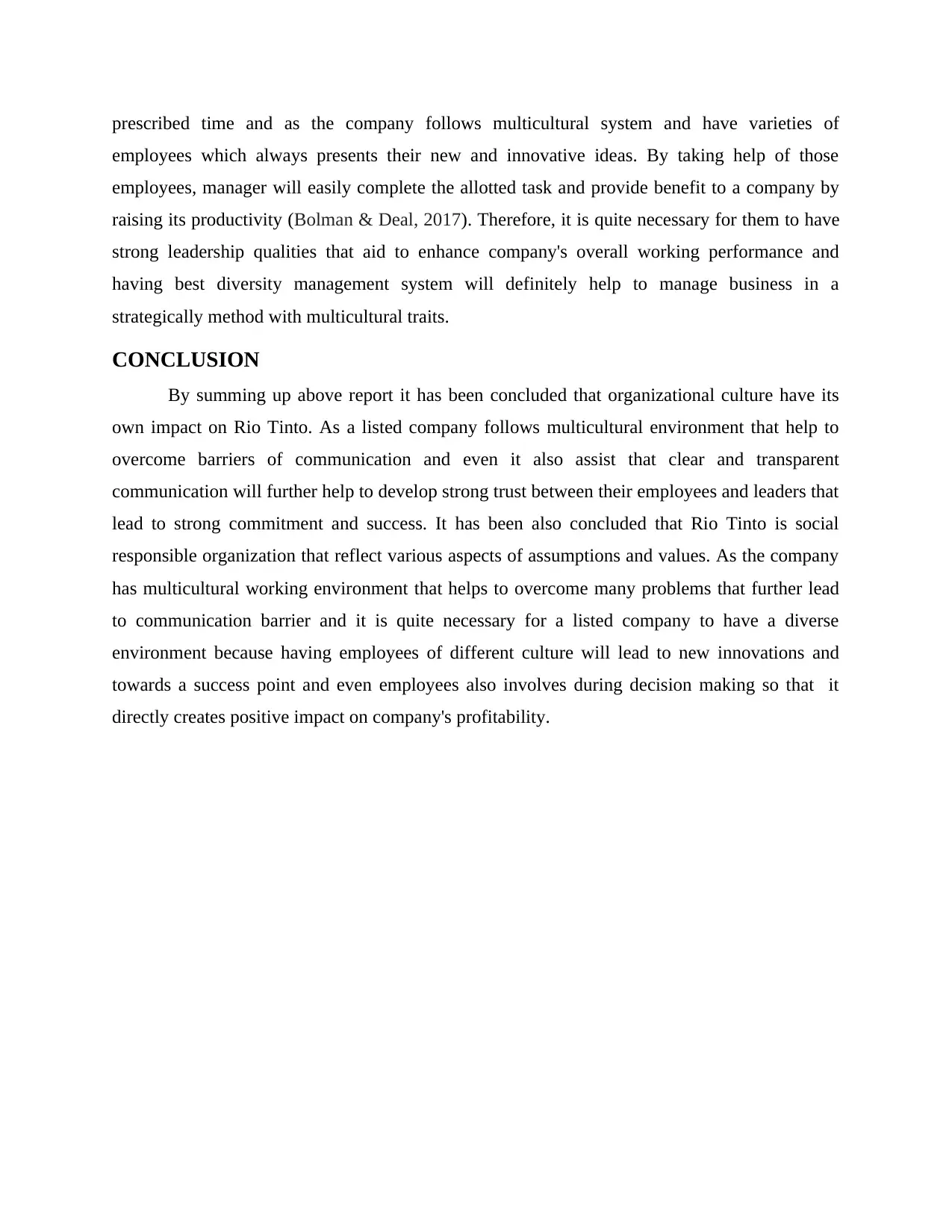
prescribed time and as the company follows multicultural system and have varieties of
employees which always presents their new and innovative ideas. By taking help of those
employees, manager will easily complete the allotted task and provide benefit to a company by
raising its productivity (Bolman & Deal, 2017). Therefore, it is quite necessary for them to have
strong leadership qualities that aid to enhance company's overall working performance and
having best diversity management system will definitely help to manage business in a
strategically method with multicultural traits.
CONCLUSION
By summing up above report it has been concluded that organizational culture have its
own impact on Rio Tinto. As a listed company follows multicultural environment that help to
overcome barriers of communication and even it also assist that clear and transparent
communication will further help to develop strong trust between their employees and leaders that
lead to strong commitment and success. It has been also concluded that Rio Tinto is social
responsible organization that reflect various aspects of assumptions and values. As the company
has multicultural working environment that helps to overcome many problems that further lead
to communication barrier and it is quite necessary for a listed company to have a diverse
environment because having employees of different culture will lead to new innovations and
towards a success point and even employees also involves during decision making so that it
directly creates positive impact on company's profitability.
employees which always presents their new and innovative ideas. By taking help of those
employees, manager will easily complete the allotted task and provide benefit to a company by
raising its productivity (Bolman & Deal, 2017). Therefore, it is quite necessary for them to have
strong leadership qualities that aid to enhance company's overall working performance and
having best diversity management system will definitely help to manage business in a
strategically method with multicultural traits.
CONCLUSION
By summing up above report it has been concluded that organizational culture have its
own impact on Rio Tinto. As a listed company follows multicultural environment that help to
overcome barriers of communication and even it also assist that clear and transparent
communication will further help to develop strong trust between their employees and leaders that
lead to strong commitment and success. It has been also concluded that Rio Tinto is social
responsible organization that reflect various aspects of assumptions and values. As the company
has multicultural working environment that helps to overcome many problems that further lead
to communication barrier and it is quite necessary for a listed company to have a diverse
environment because having employees of different culture will lead to new innovations and
towards a success point and even employees also involves during decision making so that it
directly creates positive impact on company's profitability.
⊘ This is a preview!⊘
Do you want full access?
Subscribe today to unlock all pages.

Trusted by 1+ million students worldwide
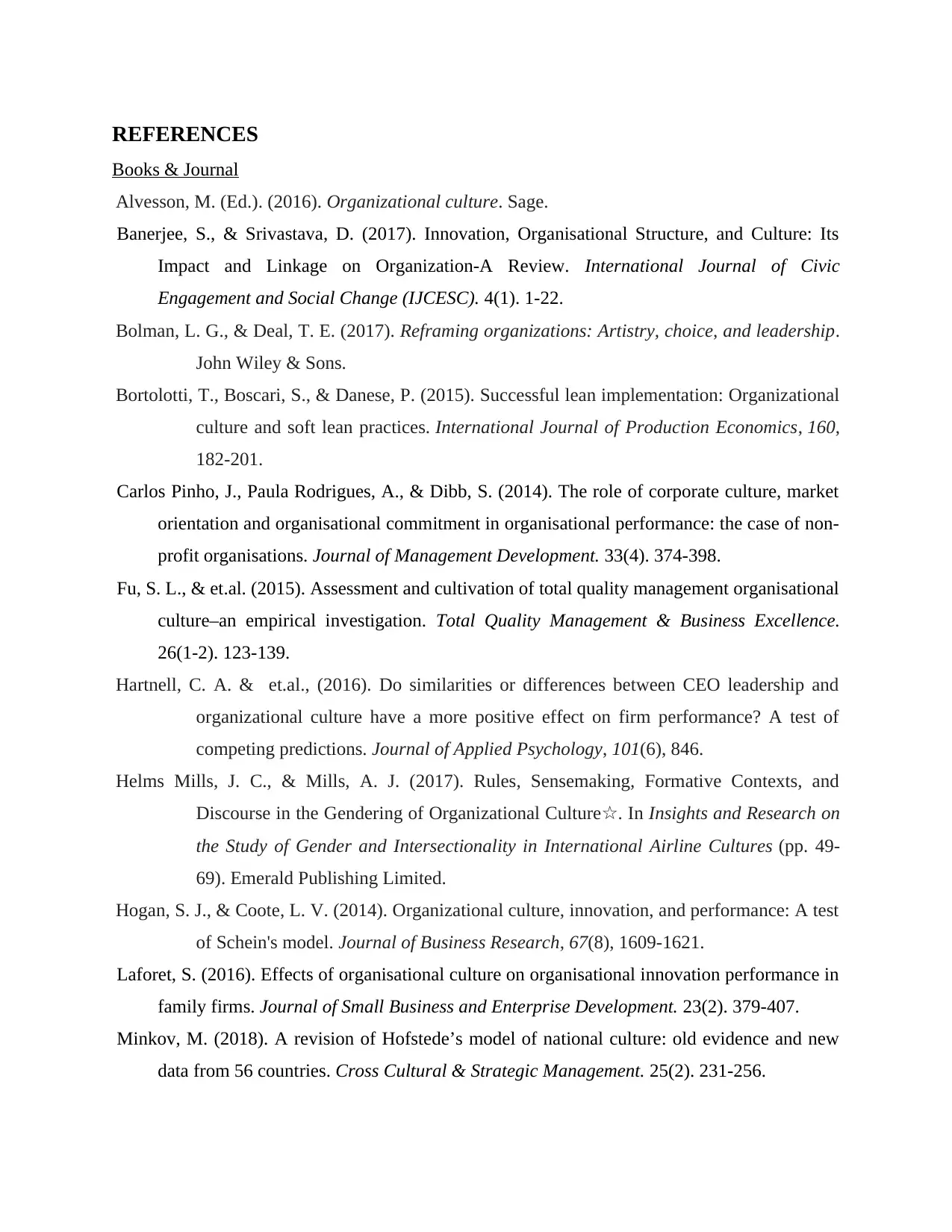
REFERENCES
Books & Journal
Alvesson, M. (Ed.). (2016). Organizational culture. Sage.
Banerjee, S., & Srivastava, D. (2017). Innovation, Organisational Structure, and Culture: Its
Impact and Linkage on Organization-A Review. International Journal of Civic
Engagement and Social Change (IJCESC). 4(1). 1-22.
Bolman, L. G., & Deal, T. E. (2017). Reframing organizations: Artistry, choice, and leadership.
John Wiley & Sons.
Bortolotti, T., Boscari, S., & Danese, P. (2015). Successful lean implementation: Organizational
culture and soft lean practices. International Journal of Production Economics, 160,
182-201.
Carlos Pinho, J., Paula Rodrigues, A., & Dibb, S. (2014). The role of corporate culture, market
orientation and organisational commitment in organisational performance: the case of non-
profit organisations. Journal of Management Development. 33(4). 374-398.
Fu, S. L., & et.al. (2015). Assessment and cultivation of total quality management organisational
culture–an empirical investigation. Total Quality Management & Business Excellence.
26(1-2). 123-139.
Hartnell, C. A. & et.al., (2016). Do similarities or differences between CEO leadership and
organizational culture have a more positive effect on firm performance? A test of
competing predictions. Journal of Applied Psychology, 101(6), 846.
Helms Mills, J. C., & Mills, A. J. (2017). Rules, Sensemaking, Formative Contexts, and
Discourse in the Gendering of Organizational Culture . In☆ Insights and Research on
the Study of Gender and Intersectionality in International Airline Cultures (pp. 49-
69). Emerald Publishing Limited.
Hogan, S. J., & Coote, L. V. (2014). Organizational culture, innovation, and performance: A test
of Schein's model. Journal of Business Research, 67(8), 1609-1621.
Laforet, S. (2016). Effects of organisational culture on organisational innovation performance in
family firms. Journal of Small Business and Enterprise Development. 23(2). 379-407.
Minkov, M. (2018). A revision of Hofstede’s model of national culture: old evidence and new
data from 56 countries. Cross Cultural & Strategic Management. 25(2). 231-256.
Books & Journal
Alvesson, M. (Ed.). (2016). Organizational culture. Sage.
Banerjee, S., & Srivastava, D. (2017). Innovation, Organisational Structure, and Culture: Its
Impact and Linkage on Organization-A Review. International Journal of Civic
Engagement and Social Change (IJCESC). 4(1). 1-22.
Bolman, L. G., & Deal, T. E. (2017). Reframing organizations: Artistry, choice, and leadership.
John Wiley & Sons.
Bortolotti, T., Boscari, S., & Danese, P. (2015). Successful lean implementation: Organizational
culture and soft lean practices. International Journal of Production Economics, 160,
182-201.
Carlos Pinho, J., Paula Rodrigues, A., & Dibb, S. (2014). The role of corporate culture, market
orientation and organisational commitment in organisational performance: the case of non-
profit organisations. Journal of Management Development. 33(4). 374-398.
Fu, S. L., & et.al. (2015). Assessment and cultivation of total quality management organisational
culture–an empirical investigation. Total Quality Management & Business Excellence.
26(1-2). 123-139.
Hartnell, C. A. & et.al., (2016). Do similarities or differences between CEO leadership and
organizational culture have a more positive effect on firm performance? A test of
competing predictions. Journal of Applied Psychology, 101(6), 846.
Helms Mills, J. C., & Mills, A. J. (2017). Rules, Sensemaking, Formative Contexts, and
Discourse in the Gendering of Organizational Culture . In☆ Insights and Research on
the Study of Gender and Intersectionality in International Airline Cultures (pp. 49-
69). Emerald Publishing Limited.
Hogan, S. J., & Coote, L. V. (2014). Organizational culture, innovation, and performance: A test
of Schein's model. Journal of Business Research, 67(8), 1609-1621.
Laforet, S. (2016). Effects of organisational culture on organisational innovation performance in
family firms. Journal of Small Business and Enterprise Development. 23(2). 379-407.
Minkov, M. (2018). A revision of Hofstede’s model of national culture: old evidence and new
data from 56 countries. Cross Cultural & Strategic Management. 25(2). 231-256.
Paraphrase This Document
Need a fresh take? Get an instant paraphrase of this document with our AI Paraphraser
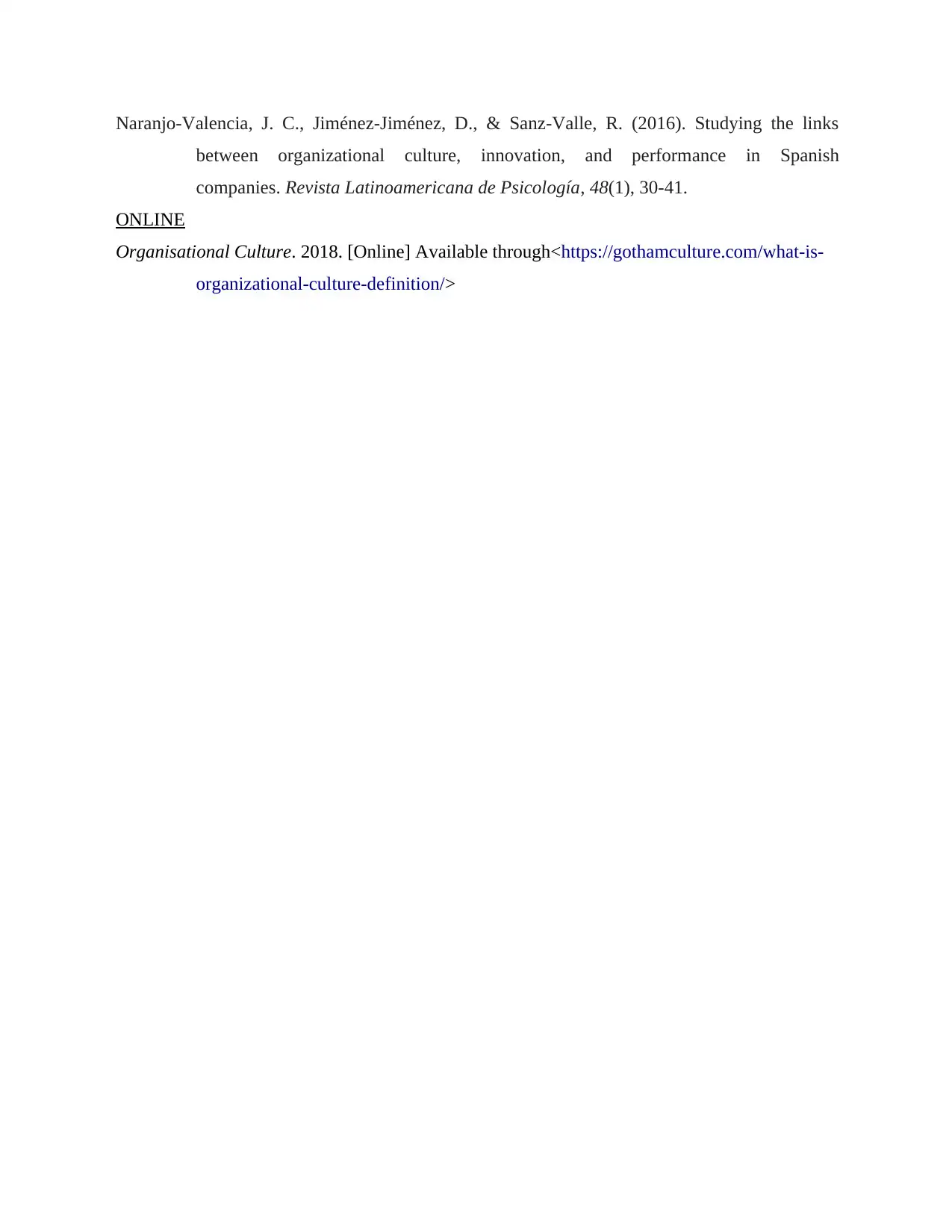
Naranjo-Valencia, J. C., Jiménez-Jiménez, D., & Sanz-Valle, R. (2016). Studying the links
between organizational culture, innovation, and performance in Spanish
companies. Revista Latinoamericana de Psicología, 48(1), 30-41.
ONLINE
Organisational Culture. 2018. [Online] Available through<https://gothamculture.com/what-is-
organizational-culture-definition/>
between organizational culture, innovation, and performance in Spanish
companies. Revista Latinoamericana de Psicología, 48(1), 30-41.
ONLINE
Organisational Culture. 2018. [Online] Available through<https://gothamculture.com/what-is-
organizational-culture-definition/>
1 out of 11
Related Documents
Your All-in-One AI-Powered Toolkit for Academic Success.
+13062052269
info@desklib.com
Available 24*7 on WhatsApp / Email
![[object Object]](/_next/static/media/star-bottom.7253800d.svg)
Unlock your academic potential
Copyright © 2020–2025 A2Z Services. All Rights Reserved. Developed and managed by ZUCOL.





